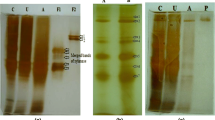Abstract
Pseudomonas solanacearum (obtained from Nigeria) produced certain pectic polysaccharidases when grown in aerobic batch cultures containing pectic substances. The pH optima of the enzymes were different. The optimum for polygalacturonase EC 3.2.2.15 was 5.5, and for pectate lyase EC 4.2.99.3 it was 8.5. The α-1,4-glycosidic bonds between galacturonide units were cleaved at random, indicating the endo character of the enzymes. The pectic polysaccharidases were purified by (NH4)2SO4 fractionation and by electrofocusing. Highest polygalacturonase activity and pectate lyase activity were obtained in the fractions at 41%–60% and 61%–80% (NH4)2SO4 saturation, respectively. Polygalacturonase was resolved into two components with isoelectric points of 5.0 and 7.5; the isoelectric point of pectate lyase was 8.1.
Similar content being viewed by others
Literature Cited
Agboola, S. D. 1976.Pseudomonas solanacearum-induced diseases in Nigeria. Proceedings of the 1st International Planning Conference and Workshop on the Ecology and Control of Bacterial Wilt caused byPseudomonas solanacearum, North Carolina (USA), pp. 75–77.
Albersheim, P., Jones, T. M., English, P. D. 1969. Biochemistry of the cell wall in relation to infective processes. Annual Review of Phytopathology7:171–194.
Albersheim, P., Neukom, H., Deuel, H. 1960. Splitting of pectin chains in neutral solutions. Archives of Biochemistry and Biophysics90:46–51.
Ayers, W. A., Papavizas, G. C., Diem, A. E. 1966. Polygalacturonate transeliminase and polygalacturonase production byRhizoctonia solani. Phytopathology56:1006–1011.
Bradford, M. 1976. A rapid and sensitive method for the quantitation of microgram quantities of protein utilizing the principle of protein-dye binding. Analytical Biochemistry72:248–254.
Cervone, F., Scala, A., Scala, F. 1977. Polygalacturonase fromRhizoctonia fragariae: further characterization of two isoenzymes and their action towards strawberry tissue. Physiological Plant Pathology12:19–26.
Chan, Y. H., Sackston, W. E. 1970. Mechanism of pathogenesis inSclerotium bataticola on sunflowers. II. Pectolytic and cellulolytic enzyme production in vitro and in vivo. Canadian Journal of Botany48:1073–1077.
Erinle, I. D. 1976. A preliminary report on bacterial wilt in Nigeria, p. 19. Samaru Miscellaneous Paper 66, Institute for Agricultural Research, Zaria.
Fogarty, W. M., Kelly, C. T. 1979. Developments in microbial extracellular enzymes. In: Wiseman, A. (ed.), Topics in enzyme and fermentation biotechnology. Chichester: Ellis Horwood Ltd.
Garibaldi, A., Bateman, D. F. 1971. Pectic enzymes produced byErwinia chrysanthemi and their effects on plant tissue. Physiological Plant Pathology1:25–40.
Hildebrand, D. C. 1971. Pectolytic enzymes ofPseudomonas, pp. 331–343. Proceedings of the 3rd International Conference on Plant Pathogenic Bacteria, Wageningen.
Kelman, A. 1954. The bacterial wilt caused byPseudomonas solanacearum. North Carolina Agricultural Experiment Station, Technical Bulletin no. 99.
Nasuno, S., Starr, M. P. 1966. Polygalacturonase ofErwinia carotovora. Journal of Biological Chemistry241:5298–5306.
Ofuya, C. O., Wood, R. K. S. 1978. Pathogenicity and biochemical characteristics of isolates ofPseudomonas solanacearum in Nigeria, pp. 835–840. Proceedings of the 4th International Conference on Plant Pathogenic Bacteria, INRA.
Ofuya, C. O., Wood, R. K. S. 1981. Virulence ofPseudomonas solanacearum in relation to extracellular polysaccharidases, pp. 270–279. Proceedings of the 5th International Conference on Plant Pathogenic Bacteria, CIAT.
Quinn, J. G. 1973. Nigeria: prospects for a tomato paste industry. Shell Public Health and Agricultural News16:252.
Starr, M. P., Moran, F. 1962. Eliminative split of pectic substances by phytopathogenic soft-rot bacteria. Science135:920–921.
Vesterberg, O. 1971. Iso-electric focussing and separation of proteins. In: Norris, J. R., Ribbons, D. W. (eds.), Methods in microbiology, vol. 5B. London: Academic Press.
Author information
Authors and Affiliations
Rights and permissions
About this article
Cite this article
Ofuya, C.O. Physical properties of pectic polysaccharidases ofPseudomonas solanacearum from Nigeria. Current Microbiology 10, 141–145 (1984). https://doi.org/10.1007/BF01576775
Issue Date:
DOI: https://doi.org/10.1007/BF01576775




